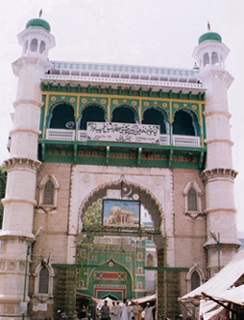
Majestic Nizam Gate at Khawaja Moin Uddin Chishti Dargah
Dr.Mazhar Naqvi
The centenary
year of Nizam Gate, the main entrance to the world famous shrine of Khwaja
Ghareeb Nawaz at Ajmer (India), is passing quietly. The gate was erected by the
last Nizam of Hyderabad Mir Osman Ali Khan in 1915. It faces the crowded Dargah
Bazar Street and stands outside the ‘Naqqar Khana’. It is recorded that the
design of majestic Nizam gate was prepared by a British engineer and it was
built at a cost of Rs.50000 under the supervision of Maulvi Habibullah of
Hyderabad state. The gate is 70 feet high and is considered to be a landmark of
Ajmer. The raised steps beneath Nizam gate were constructed during Akbar's
regime to prevent flood water from entering the shrine complex of great Chishti
Sufi.
Mir Osman
Ali Khan had ascended the throne of Hyderabad in 1911. His state was the
largest princely state of British India with an area of 223,000 square
kilometers. He portrayed on the cover of Time magazine on 22 February 1937
as the world's richest man. Personality wise, the Nizam possessed traits like
Mughal emperors Shah Jahan and Alamgir Aurangzeb. Mir Osman Ali was a great
builder like Shah Jahan but also had miserly tendencies and strange behavior at
times like Aurangzeb. He was a man of mood swings. He could be extremely
generous as well as miser at times.
Nearly all the major public buildings of
Hyderabad such as the Osmania General Hospital, Andhra Pradesh High
Court, Asafiya Library now known as State Central Library, Town
Hall, Jubilee Hall, Hyderabad Museum, Nizamia Observatory and Osmania.
University were built during his 37-year long rule and bear testimony to the
generosity and benevolence of Mir Osman Ali Khan who was the highest-ranking
ruler in India. The British conferred upon him the unique title of "His
Exalted Highness" and "Faithful Ally of the British Crown" after
the First World War. He was also entitled for 21-gun salute-a privilege given
to only five princely states of India by the British Crown.
Mir Osman Ali Khan had ordered the
construction of Nizam gate during his visit to the shrine of Khwaja Moin Uddin
Chishti in 1912.Nearly three years took its completion and it was
dedicated to the shrine in 1915.The gate also houses Naqqar Khana in its upper
story where musicians play Naubat ( Shehnai music) at the appointed hours. The
devotees arriving from different parts of India and abroad enter the shrine
complex mostly from Nizam Gate. The Khadims of Dargah usually greet them at the
gate and help them in performing Ziyarat in the appropriate manner. Nizam Gate
surely adds grace to the imposing and impressive Dargah complex that also has
beautiful mosques and courtyards built by Mughal emperors like Akbar, Jahangir
and Shah Jahan besides the extensions and additions by Scindia rulers and
British officials.
Mir Osman patronized education, science and undertook
developmental works .He introduced electricity, railways, roads and even
airways. After annexation of Hyderabad, he was appointed as Raj Pramukh (Head
of the state) on 26 January 1950 –a position that he held till October
31,1956. He died on Friday, 24 February 1967 to mark the end . of a
princely era. As Nizam gate is a symbol of his great devotion to Khwaja Ajmeri,
it would be in appropriateness of things to organize a function to mark the
centenary of the Gate erected by Mir Osman Ali Khan. Dargah committee can take
initiative in this context as there are still over four months left in
2015.(References available on request)
No comments:
Post a Comment